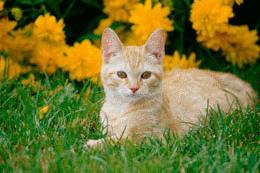Though a common skin problem in
cats, acne outbreak often goes unnoticed for a long time, which, in turn, makes
the animal vulnerable to various other health problems.
Cats,
irrespective of age, gender, or breed are affected by acne. The sebum secreted
by their sebaceous glands lubricates their skin and helps in preventing dryness
and irritation. When the hair follicles to which these glands are connected get
blocked, they develop into black heads, and these black heads―when irritated,
infected, or swollen―give rise to painful pustules that are typically
associated with acne outbreak.
Causes
 |
| Feline Acne |
In felines, acne can be caused as a result of stress, poor grooming habits,
hyperactive sebaceous glands, food allergies, etc. A suppressed immune system,
contact dermatitis, atopic dermatitis, and other such skin conditions may also
trigger this problem at times. Some people feed their cats in plastic tray,
unaware of the fact that these trays are safe haven for bacteria. Coming in
contact with these bacteria whilst feeding may also make your pet vulnerable to
acne.
Symptoms
The symptoms of this condition are so mild that they most often go unnoticed
for a long time. If you check the region around the cat's chin and lips
carefully, you will see comedones or black spots resembling dirt in these
regions. If the cat scratches the swollen red pustules because of the
irritation and discomfort they cause, they can burst and start bleeding.
Treatment
The treatment of acne in cats primarily revolves around the removal of excess
sebum. In mild cases, a topical application of antibiotic soap, hydrogen
peroxide, or iodine (Betadine) may be followed. Severe cases can be treated
with an ointment or gel that contains benzoyl peroxide or chlorhexidine. As for
inflammation, it can be reduced by applying topical glucocorticoids.
Home Remedies
If your cat is affected by acne, you can wash its facial area with an
antibacterial soap. In this case, you need to make sure that you rinse its face
thoroughly with warm water and pat it dry with a soft towel. Yet another home
remedy involves the use of Epsom salts in warm water. You need to mix 2
tablespoons of Epsom salts in one quart of warm water, soak a rag or cotton
ball in the mixture, and hold it against the cat's chin for about 5 minutes.
If left untreated, feline acne may lead to folliculitis―an infection of the
hair follicles that resembles acute acne outbreak in humans. The follicles
develop pus and the lymph nodes become swollen and sore. If your cat suffers
from this condition, you should consult a vet without wasting a minute.
Read more at Buzzle: http://www.buzzle.com/articles/feline-acne.html

Post a Comment